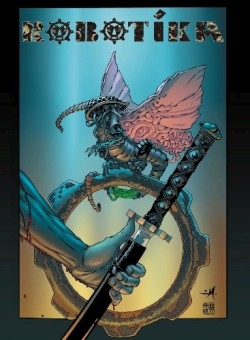Robotika
- 2006 INDIES Winner
- Bronze, Graphic Novels & Comics (Adult Nonfiction)
Take a futuristic world and mix in two parts honorable samurai, a dash of a Western motif, and two reliable albeit eccentric sidekicks, and pray it will come out to be anything akin to this graphic novel. In the “far future,” scientists struggle to merge biology and technology into the next step of evolution: cyborgian genesis. In his latest experiment, Dr. Rha Agon has finally bridged this gap, but cyborg assassins steal his research, after dispatching the doctor. Niko, a silent but skillful yojimbo, or bodyguard of the Queen, is sent to recapture the stolen research. Niko pursues the assassins into the wastelands and beyond, but just when he reaches his mission’s end, he is catapulted into a grander scheme.
The author wrote and drew Moonstruck and illustrated Bloodlust, as well as a number of short stories and books for independent publishers, and projects for Marvel and DC, including a StingRay story. Here, Sheikman’s narrative style relies heavily on his art, refusing to crowd his colorful yet solemn panels. Yet when he does impose text on the panels, he chooses words carefully, utilizing language to provide concise definitions. Though the world he creates vastly differs from reality, he injects words like “ecorganic towers” to effectively describe living skyscrapers that thrive off ecological fuel systems.
Since Niko does not speak, words embody a certain presence in this book. Sheikman plays with presentation of the text, including borderless dialogue from a cryptic entity and vertical speech from Cherokee Geisha, Niko’s sidekick. Geisha’s vertical text indicates an accent but may prove challenging to readers. Rather than letters running left to right as in the English language, Sheikman runs Geisha’s letters from top to bottom. Readers must piece words together letter to letter which stilts the reading and narrative process.
Two pieces—the background stories of Niko’s two sidekicks, Geisha and Bronski—accompany the main story. “Bronski’s Tale” explains how he came to be a yojimbo like Geisha and Niko. Immediately, the different art style is noticeable to its detriment, attempting a more realistic appearance but remaining inconsistent with backgrounds. Sheikman scripted and laid out this part of the story, but left the art to Leif Jones. “Cherokee Song” is also drawn by another person, Joel Chua, whose manga influence is obvious in the iconic and cartoonish style of his background story of Geisha. The graphic novel also includes “The World of Robotika,” a small but useful appendix about key aspects of the futuristic world. Additionally, Sheikman provides a brief gallery of full-page colored drawings, mostly featuring Niko.
Action and intrigue drive this tale whose silencing panels provoke its own soundtrack in the mind of readers. Sheikman provides a compelling, self-contained tale that certainly could go in many different directions, if he decides to pursue it. Regardless, readers will be enthralled with the art and tone of this graphic novel.
Reviewed by
Lance Eaton
Disclosure: This article is not an endorsement, but a review. The publisher of this book provided free copies of the book to have their book reviewed by a professional reviewer. No fee was paid by the publisher for this review. Foreword Reviews only recommends books that we love. Foreword Magazine, Inc. is disclosing this in accordance with the Federal Trade Commission’s 16 CFR, Part 255.


